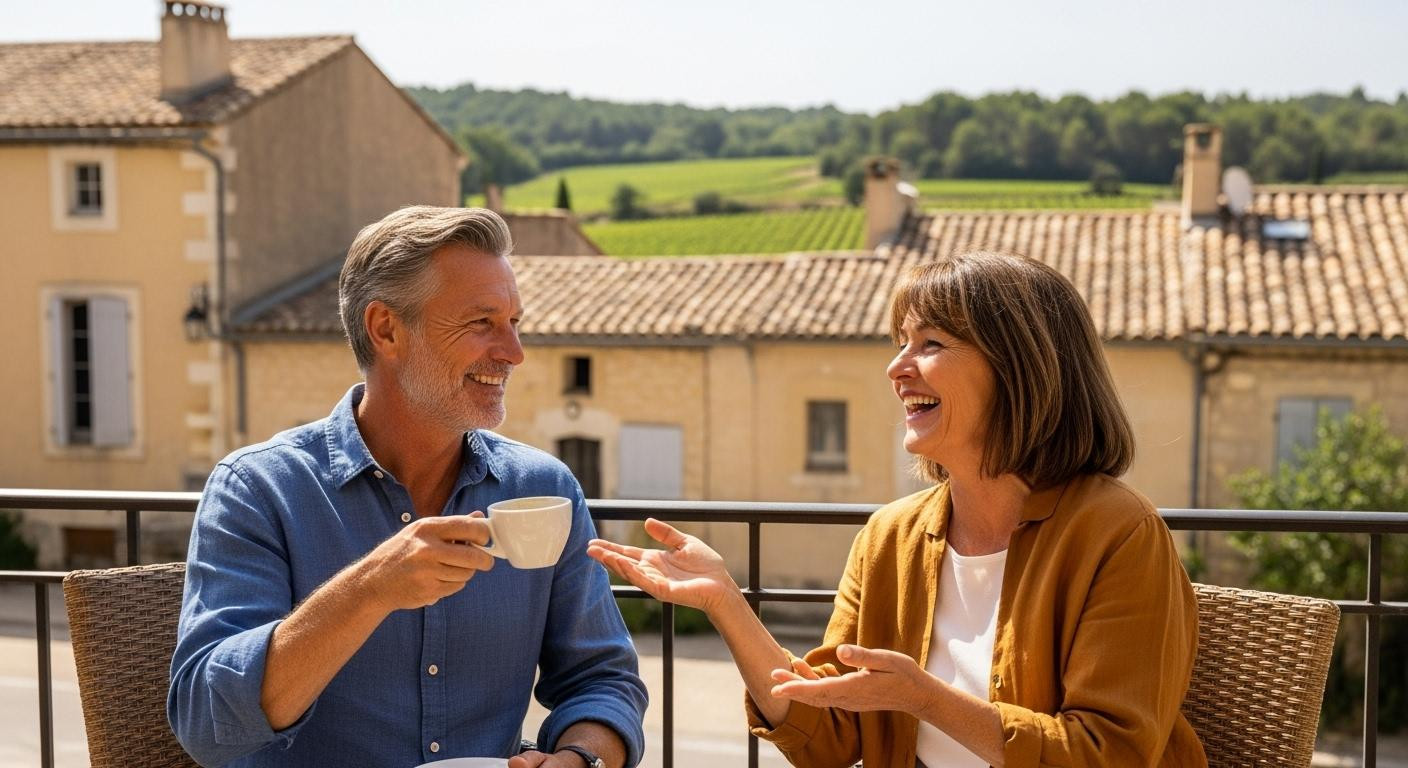At 7:15am in Lacoste, golden light touches terracotta rooftops while a local baker arranges fresh bread on Café de France’s terrace. Below, endless vineyard rows stretch toward Bonnieux’s hilltop silhouette. This is the Luberon breakfast tourists never witness: simple, authentic, rooted in centuries of Provençal tradition that locals quietly protect.
The Luberon café ritual tourists never witness
Arriving at hilltop villages like Lacoste, Ménerbes, and Bonnieux reveals the setting locals treasure. Golden limestone walls glow warmly against deep green vineyard rows. Terracotta rooftops crown ancient buildings perched 1,200-1,970 feet above sea level.
Locals arrive differently than tour groups. They walk from nearby homes or drive personal cars, not charter buses. They choose shaded corners away from main terraces, preferring working vineyard views over Instagram-perfect hilltops.
Timing matters deeply here. Vignerons gather at 7:30am for coffee and morning planning. Lunch happens at 12:15pm, not the tourist rush at 1:30pm. This intimate European food culture creates authentic experiences tourists rarely discover.
What’s actually on local plates (not the tourist menu)
The revelation strikes immediately: authentic Luberon dining costs $25-49 per person while tourist restaurants charge $61-77. Local café menus change with seasons, not marketing calendars.
The forgotten starters: tapenade, olive oil, fresh bread
Homemade black olive tapenade made from last year’s harvest appears on every local table. Freshly pressed olive oil from Château d’Estoublon costs $14 per starter serving. Village boulangeries supply crusty bread baked in wood-fired ovens using recipes unchanged since 1953.
Tourists order bottled tapenade for $20. Locals ask for “notre tapenade maison” and pay half that price.
Seasonal mains harvested this morning
October brings chestnuts from local harvests and game from hunting season. Heirloom tomatoes with burrata cost $26 at authentic cafés. Sea bass with fresh herbs runs $32, featuring fish from Mediterranean waters 93 miles south.
Spelt risotto showcases Provençal agriculture while ratatouille uses vegetables from morning markets. These harvest traditions reflect actual farming seasons, not tourist expectations.
The three café terraces locals protect
Café de France, Lacoste: vignerons’ morning gathering
This terrace hosts 330 Lacoste residents’ daily rituals. Dusty plastic chairs overlook working vineyards toward Bonnieux, 4.3 miles east. Coffee costs $3.30, homemade tapenade runs $14, and conversations happen in Provençal dialect.
Vignerons discuss harvest schedules over “petit blanc” wine at 8am. Tourist guidebooks mention scenic views but miss the authentic social fabric.
Domaine de Marie and château terraces
Vineyard estates offer lunch menus from $25-44 featuring produce from estate gardens. Rosé wine comes from surrounding vines, not national distributors. Tables sit under ancient plane trees where art installations blend with working agriculture.
Locals ignore the sculptures tourists photograph. They focus on seasonal vegetables and estate wines representing true terroir. These under-the-radar European experiences offer authentic alternatives to commercialized destinations.
Why October transforms the vineyard table
Autumn harvest season creates communal energy throughout Luberon villages. Vendange (grape harvest) runs September 20-October 15, bringing vineyard workers to local cafés for post-harvest celebrations.
Golden light at sunset (7:15pm on October 20) extends dining hours from 6:00-7:30pm. Fewer tourists after summer’s peak allows locals to reclaim their terraces. Cooler temperatures averaging 54-72°F make outdoor dining comfortable.
Local markets burst with autumn produce: chestnuts, wild mushrooms, and first-pressed olive oil from 2025 harvest. This seasonal transformation reveals why locals consider October ideal for authentic Provençal experiences.
Your questions about Luberon vineyard cafés answered
How much does a typical lunch cost compared to Paris or Côte d’Azur?
Authentic vineyard lunches cost $25-44 in Luberon villages versus $55+ in tourist-heavy Provence spots or $66+ in Paris bistros. Wine by the glass runs $8-10 for local AOC varieties. Accommodation ranges $132-176 nightly compared to $242-385 on the Côte d’Azur.
What should I order to eat like a local, not a tourist?
Skip prix-fixe menus marketed to tourists. Order homemade tapenade with local olive oil as starter ($14). Choose seasonal vegetable mains ($26-35) and rosé wine from the estate ($8-10 per glass). Avoid “Provençal platters” featuring multiple out-of-season items designed for cameras, not taste.
How does this compare to Tuscany’s vineyard dining?
Luberon offers $25-44 lunches with 45% local customers versus Tuscany’s $38+ minimum with 15% locals. Tourist density in Lacoste (125 daily visitors) stays 68% lower than comparable Tuscan hill towns. Similar golden landscapes, half the commercialization.
At 6:47pm, sunset gilds Bonnieux’s ancient stones while a grandmother finishes coffee at Domaine de Marie’s terrace. Vineyard rows glow copper below, cicadas sing softly, and the scent of rosemary drifts on autumn air. This is the Provence locals protect: where meals move slowly, food tastes of soil and season.
